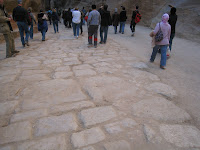The Petra Panorama Hotel certainly lived up to its name. We opened our window to this beautiful vista in the morning:

After breakfast and devotions we headed out to Petra. Petra has recently been listed as one of the new seven wonders of the world. The site was discovered in modern times in 1812 and only 9% of the site has been excavated. Petra is renowned for its rock-cut architecture - to date only one freestanding building has been found in Petra (a temple), for everything else had been cut into the rock. The most famous building in Petra, called the Treasury, was used in the movie, Indiana Jones and the Last Crusade, and there are several gift shops around featuring Indiana Jones memorabilia.
Biblically speaking, the area of Petra was settled by the descendants of Esau, known as the Edomites. Moses and the Israelites were denied passage through Edom on their way to the Promised Land. Also Moses' brother died on the outskirts of this region and is buried on top of one of the mountains. A few of Petra's kings are mentioned in Scripture and Petra is also mentioned in the Dead Sea Scrolls.
But the most famous residents of Petra and the ones responsible for all of the beautiful carvings are the Nebateans, who settled in this area around 400 BC after coming from northern Arabia. Petra then was a major crossroads for several trade routes. Their civilization lasted until about 300AD when the Roman Empire shifted the trade routes towards Baghdad.
Biblically speaking, the area of Petra was settled by the descendants of Esau, known as the Edomites. Moses and the Israelites were denied passage through Edom on their way to the Promised Land. Also Moses' brother died on the outskirts of this region and is buried on top of one of the mountains. A few of Petra's kings are mentioned in Scripture and Petra is also mentioned in the Dead Sea Scrolls.
But the most famous residents of Petra and the ones responsible for all of the beautiful carvings are the Nebateans, who settled in this area around 400 BC after coming from northern Arabia. Petra then was a major crossroads for several trade routes. Their civilization lasted until about 300AD when the Roman Empire shifted the trade routes towards Baghdad.
Part of Petra is a beautiful gorge call the "Siq". During the Roman occupation a arch was put in place marking the entrance to the gorge. It fell during an earthquake since Petra's discovery in 1812. On the sides of the walls you can see the carvings for the sides of the arch.






Petra was annexed by the Roman Empire in 106 AD and this is a section of the road the Romans laid through the city. In some places if you look closely you can see long grooves cut into the stones from chariot wheels!




The Nebateans were ingenious in figuring out how to control water. In some places they built tunnels to capture water and prevent flash flooding. For drinking water they had channels dug to bring water into the city (you can see on the lower left hand side) and in some places also used baked clay pipes to carry water.
The Treasury in all its glory. It got its name because people assumed upon finding it that it was some kind of treasure storehouse - in fact there are bullet marks on the big urn at the top because treasure hunters tried to shoot it open convinced gold would pour out. But it turns out it that the Treasury was really a royal tomb. In fact most of the 700 structures found so far in Petra are tombs.
This picture shows the footholds carved into the rock for the sculptors to use. Buildings were carved from top to bottom.




















No comments:
Post a Comment